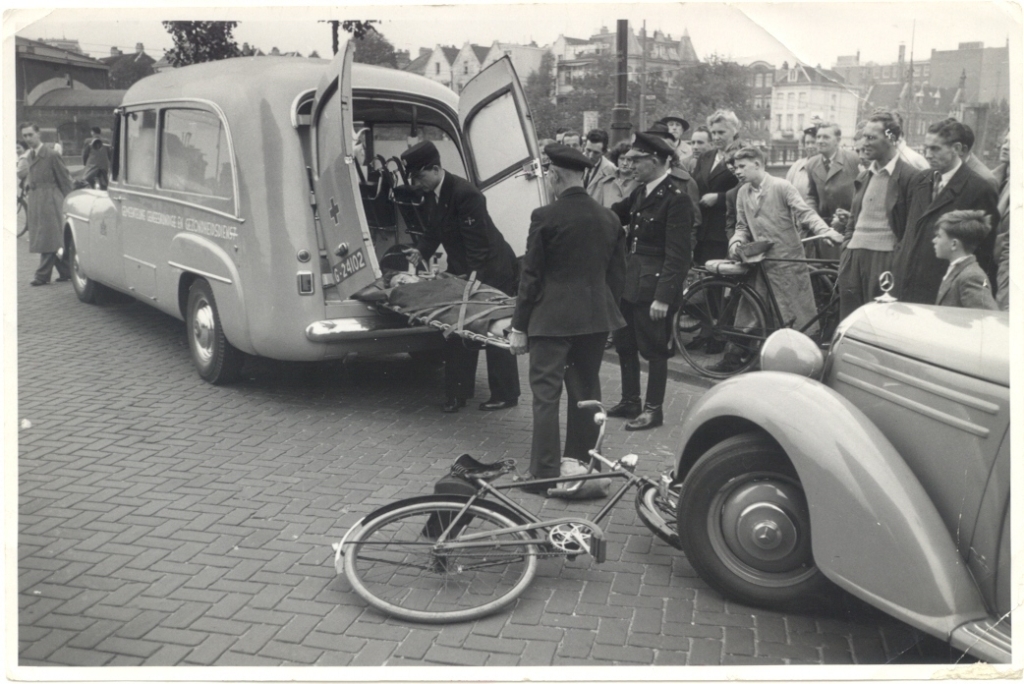Accidents are no film set
Author: Thijs Gras 
Published in: Spring 2019 Edition of Ambulance Today Magazine
EMS staff have enough to deal with when responding to a call, the last thing they need is members of the public making harder work of it. In this column, Thijs Gras explains the difference between ‘innocent inquisitiveness’ and ‘sick sensationalism’ when it comes to the scene of an accident.
We got a call: probable resuscitationin a tram. When we arrived we founda man of about 70 years lying on the ground in a tiny space inside the tram. It was cold and rainy, so carrying him outside was not an option, at least not without proper preparation for which we had no time. The police were already performing CPR, all the passengers were out of the tram. We pulled the man a little under to create a bit more space and took over the resuscitation. While I was ballooning the man I suddenly noticed someone on the outside, looking curiously through the window of the tram as to what we were doing there.I was amazed and so were the police. After this guy was chased away, only a couple of moments later a woman took over. She gazed inside.
Now I must admit I have a certain degree of understanding, people being inquisitive when something happens involving lights and sirens. Mankind is naturally curious. In my younger years hearing the fire service acceleratedmy heartbeat and if I knew where they were going to, I went as well. A fire is fascinating to see. Smoke and flames, lights and sirens attract attention, which generally is okay, as long as you do not come too near or hamper rescue and/or fire fighting operations.
Labelling it positively, one could referto this as interest in the community, in society, in other people. The attraction could even have an evolutionary use: it is a way to mobilize help and assistance. It is only relatively recently that rescue and emergency medical care outside the hospital is professionalized and trusted to specially trained people from dedicated organizations and services. But even nowadays we value first responders and bystanders because they have one big advantage over the professionals: time. Professionals need to be informed there is a problem,find out where it is and who shouldbe handling this, and then alert the required units to rush to the scene. All these steps take time, so having people around to extinguish a fire, control a bleeding or perform CPR may be of great value.
But there are boundaries. Some people prefer filming to rendering first aid.This is ridiculous of course. Even after emergency services arrived on the scene and are doing their job, people may come very close, sometimes too close for comfort. Being a historian, I went through a lot of pictures of accidents. One would be amazed by the number of people watching accidents on some of the older pictures. Apparently this is of all ages. In the Netherlands we call this ‘disaster tourism’.
But do not forget, it may be dangerous! Even in The Netherlands we had a nasty experience in this field with the big explosion of a firework factory in the town of Enschede in May 2000. Among the 22 fatalities (including four fire fighters) and about 950 injured, were a number of people that had come to the incident just out of curiosity.

In recent years cell phones and iPhones have taken sensationalism a step further; everything is filmed nowadays. You make your own reality TV and broadcast it among your friends or nasty news channels. With a bit of luck your footage goes viral.
Last year in August there was a big collision on one of the Dutch highways. One person was so seriously injured he had to be resuscitated. People were filming everything. They bashed through the accident scene trying to get the best pictures, destroying important marks for the police investigation. They used lanes, marked with red crosses. A car even stopped on the opposite side of the motorway to film the accident, almost causing another accident with an oncoming lorry. Police noted as many registration plates as possible to give these people a big fine. Will they learn?
There are thin lines between innocent inquisitiveness, caring curiosity,sick sensationalism and pathologic papparazionism. The first two are relatively okay and can be dealt with, the other two are not okay and refutable.
As ambulance crews we ask the right honourable members of the public not to film patients and victims. And if you are struggling against the temptation, just reflect before you film: “What if this was me or my mother or my father? Do I want to go viral?” Accidents are no film sets. . .
Quality content
- Casinos Not On Gamstop
- Casinos Not On Gamstop
- Casino Sites Not On Gamstop
- Non Gamstop Casino
- UK Online Casinos Not On Gamstop
- Casino Sites Not On Gamstop UK
- Casino Sites Not On Gamstop
- Games Not On Gamstop
- Sites Not On Gamstop
- UK Online Casinos Not On Gamstop
- Casino Not On Gamstop
- Slots Not On Gamstop
- Casino Not On Gamstop
- Gambling Not On Gamstop
- Casinos Not On Gamstop
- Non Gamstop Casino
- UK Online Casinos Not On Gamstop
- Casino Sites Not On Gamstop
- Best Betting Sites
- Best UK Online Casinos
- New Horse Racing Betting Sites
